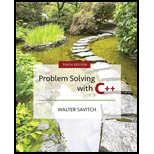
Problem Solving with C++ (10th Edition)
10th Edition
ISBN: 9780134448282
Author: Walter Savitch, Kenrick Mock
Publisher: PEARSON
expand_more
expand_more
format_list_bulleted
Concept explainers
Question
Chapter 18, Problem 7PP
Program Plan Intro
Permutations using “set” class
Program Plan:
- Include required header file.
- Include required “std” namespace.
- Function declaration for display permutations, compute permutations, and display the content of list in set.
- Define main function.
- Call the function “displayPermutations” function.
- Define “displayPermutations” function.
- Declare variable “set1” in “set” template class.
- Declare variable “p” in “set” template class with “list” class of “int” type.
- Fill the set with the first “n” whole numbers.
- Display given statement.
- Initializes a variable “iter” to “0”.
- Display permutation set using for loop.
- Compute the possible set for given set by calling the function “computePermutations”.
- Display the set elements by calling the function “displayLists”.
- Define “computePermutations” function.
- Declare variable “result” in “set<list<int> >”.
- If the number size is equal to “1”, then push the iterator begin value to given list and then insert the list into set “result”.
- Otherwise, recursively call the function “computePermutations”
- Define “displayLists” function.
- Display the content of list using “for” loop.
Expert Solution & Answer
Want to see the full answer?
Check out a sample textbook solution
Students have asked these similar questions
4. |z + 5 - 5i| = 7
14.
dz,
C: |z❘
C: |z❘ = 0.6
ze² - 2iz
H
14.
dz,
C: |z❘
C: |z❘ = 0.6
ze² - 2iz
H
Chapter 18 Solutions
Problem Solving with C++ (10th Edition)
Ch. 18.1 - If v is a vector, what does v.begin() return? What...Ch. 18.1 - If p is an iterator for a vector object v, what is...Ch. 18.1 - Suppose v is a vector of ints. Write a for loop...Ch. 18.1 - Suppose the vector v contains the letters 'A',...Ch. 18.1 - Suppose the vector v contains the letters 'A',...Ch. 18.1 - Suppose you want to run the following code, where...Ch. 18.2 - Prob. 7STECh. 18.2 - Prob. 8STECh. 18.2 - Prob. 9STECh. 18.2 - Prob. 10STE
Ch. 18.2 - Prob. 11STECh. 18.2 - Prob. 12STECh. 18.2 - Prob. 13STECh. 18.2 - Prob. 14STECh. 18.2 - Prob. 15STECh. 18.2 - Prob. 16STECh. 18.3 - Prob. 17STECh. 18.3 - Prob. 18STECh. 18.3 - Prob. 19STECh. 18.3 - Suppose v is an object of the class vectorint. Use...Ch. 18.3 - Prob. 21STECh. 18.3 - Can you use the copy template function with vector...Ch. 18.3 - Prob. 23STECh. 18 - Prob. 1PCh. 18 - Prob. 2PCh. 18 - Prob. 3PCh. 18 - Prob. 4PCh. 18 - Write a program that allows the user to enter any...Ch. 18 - Prob. 3PPCh. 18 - Prob. 5PPCh. 18 - Solution to Programming Project 18.6 In this...Ch. 18 - Prob. 7PPCh. 18 - You have collected a file of movie ratings where...Ch. 18 - Prob. 9PPCh. 18 - Prob. 11PPCh. 18 - Write a program that uses regular expressions to...
Knowledge Booster
Learn more about
Need a deep-dive on the concept behind this application? Look no further. Learn more about this topic, computer-science and related others by exploring similar questions and additional content below.Similar questions
arrow_back_ios
SEE MORE QUESTIONS
arrow_forward_ios
Recommended textbooks for you
 C++ for Engineers and ScientistsComputer ScienceISBN:9781133187844Author:Bronson, Gary J.Publisher:Course Technology Ptr
C++ for Engineers and ScientistsComputer ScienceISBN:9781133187844Author:Bronson, Gary J.Publisher:Course Technology Ptr C++ Programming: From Problem Analysis to Program...Computer ScienceISBN:9781337102087Author:D. S. MalikPublisher:Cengage LearningProgramming Logic & Design ComprehensiveComputer ScienceISBN:9781337669405Author:FARRELLPublisher:Cengage
C++ Programming: From Problem Analysis to Program...Computer ScienceISBN:9781337102087Author:D. S. MalikPublisher:Cengage LearningProgramming Logic & Design ComprehensiveComputer ScienceISBN:9781337669405Author:FARRELLPublisher:Cengage New Perspectives on HTML5, CSS3, and JavaScriptComputer ScienceISBN:9781305503922Author:Patrick M. CareyPublisher:Cengage Learning
New Perspectives on HTML5, CSS3, and JavaScriptComputer ScienceISBN:9781305503922Author:Patrick M. CareyPublisher:Cengage Learning EBK JAVA PROGRAMMINGComputer ScienceISBN:9781337671385Author:FARRELLPublisher:CENGAGE LEARNING - CONSIGNMENT
EBK JAVA PROGRAMMINGComputer ScienceISBN:9781337671385Author:FARRELLPublisher:CENGAGE LEARNING - CONSIGNMENT Microsoft Visual C#Computer ScienceISBN:9781337102100Author:Joyce, Farrell.Publisher:Cengage Learning,
Microsoft Visual C#Computer ScienceISBN:9781337102100Author:Joyce, Farrell.Publisher:Cengage Learning,

C++ for Engineers and Scientists
Computer Science
ISBN:9781133187844
Author:Bronson, Gary J.
Publisher:Course Technology Ptr

C++ Programming: From Problem Analysis to Program...
Computer Science
ISBN:9781337102087
Author:D. S. Malik
Publisher:Cengage Learning

Programming Logic & Design Comprehensive
Computer Science
ISBN:9781337669405
Author:FARRELL
Publisher:Cengage

New Perspectives on HTML5, CSS3, and JavaScript
Computer Science
ISBN:9781305503922
Author:Patrick M. Carey
Publisher:Cengage Learning

EBK JAVA PROGRAMMING
Computer Science
ISBN:9781337671385
Author:FARRELL
Publisher:CENGAGE LEARNING - CONSIGNMENT

Microsoft Visual C#
Computer Science
ISBN:9781337102100
Author:Joyce, Farrell.
Publisher:Cengage Learning,